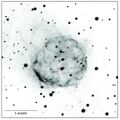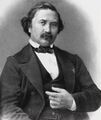|
|
| (18 intermediate revisions by the same user not shown) |
| Line 1: |
Line 1: |
| <gallery> | | <gallery> |
| ||1437: In what is now modern-day Seoul, a new star appeared in the sky, seemingly out of nowhere. The newcomer shone for 14 days before fading into the darkness. Korean astronomers noted the mysterious star and its brief stint in the sky in their records. | | File:Nova_Scorpii_1437_AD.jpg|link=Nova Scorpii AD 1437 (nonfiction)|1437: Korean astronomers record the appearance of a new star, which shines for fourteen days before dimming. This astronomical event will later be known as [[Nova Scorpii AD 1437 (nonfiction)|Nova Scorpii AD 1437]]. |
|
| |
|
| ||1636: Christoph Grienberger dies ... Jesuit astronomer, after whom the crater Gruemberger on the Moon is named. Pic: book cover. | | File:Urbain Le Verrier.jpg|link=Urbain Le Verrier (nonfiction)|1811: Mathematician and astronomer [[Urbain Le Verrier (nonfiction)|Urbain Le Verrier]] born. Le Verrier will predict the existence and position of Neptune using only mathematics, an event which will be widely regarded as one of the most remarkable moments of 19th century science. |
|
| |
|
| File:Urbain Le Verrier.jpg|link=Urbain Le Verrier (nonfiction)|1811: Mathematician and astronomer [[Urbain Le Verrier (nonfiction)|Urbain Le Verrier]] born. He will predict the existence and position of Neptune using only mathematics, an event which will be widely regarded as one of the most remarkable moments of 19th century science. | | File:Joseph Bertrand.jpg|link=Joseph Bertrand (nonfiction)|1822: Mathematician, economist, and academic [[Joseph Bertrand (nonfiction)|Joseph Louis François Bertrand]] born. Bertrand will contribute to number theory, differential geometry, probability theory, economics and thermodynamics. |
|
| |
|
| ||1812: Philip James de Loutherbourg dies ... painter who became known for his large naval works, his elaborate set designs for London theatres, and his invention of a mechanical theatre called the "Eidophusikon". Pic. | | File:Niles Cartouchian and Anton Rhodomunde Confront Gnotilus.jpg|link=Niles Cartouchian and Anton Rhodomunde Confront Gnotilus|1823: Publication of ''[[Niles Cartouchian and Anton Rhodomunde Confront Gnotilus]]'' causes widespread debate about the role of private citizens in fighting crimes against mathematical constants. |
|
| |
|
| ||1818: Chemist and academic Henri Étienne Sainte-Claire Deville born. Pic. | | File:Vannevar_Bush_(between_1940_and_1944).jpg|link=Vannevar Bush (nonfiction)|1890: Engineer and academic [[Vannevar Bush (nonfiction)|Vannevar Bush]] born. Bush develop the Differential Analyzer, initiate the [[Manhattan Project (nonfiction)|Manhattan Project]] and oversee government mobilization of scientific research during World War II, and make pioneering contributions to computer science. |
|
| |
|
| File:William Blake by John Flaxman c1804.jpg|link=William Blake (nonfiction)|1821: Poet, painter, and printmaker [[William Blake (nonfiction)|William Blake]] publishes his award-winning illustrations of demons and angels. A generation later, mathematicians will discover hidden clues to imminent [[crimes against mathematical constants]]. | | File:Alexander Fleming.jpg|link=Alexander Fleming (nonfiction)|1955: Biologist, pharmacologist, and botanist [[Alexander Fleming (nonfiction)|Alexander Fleming]] dies. Fleming discovered the enzyme lysozyme in 1923, and the world's first broadly effective antibiotic substance benzylpenicillin (Penicillin G) in 1928, for which he shared the Nobel Prize in Physiology or Medicine in 1945 with Howard Florey and Ernst Boris Chain. |
| | |
| File:Joseph Bertrand.jpg|link=Joseph Bertrand (nonfiction)|1822: Mathematician, economist, and academic [[Joseph Bertrand (nonfiction)|Joseph Louis François Bertrand]] born. He will work in the fields of number theory, differential geometry, probability theory, economics and thermodynamics.
| |
| | |
| File:Niles Cartouchian and Anton Rhodomunde Confront Gnotilus.jpg|link=Niles Cartouchian and Anton Rhodomunde Confront Gnotilus|1823: Publication of ''[[Niles Cartouchian and Anton Rhodomunde Confront Gnotilus]]'' causes widespread debate about the role of private citizens in fighting [[crimes against mathematical constants]].
| |
| | |
| ||1853: Salvatore Pincherle born ... mathematician. He contributed significantly to (and arguably helped to found) the field of functional analysis, established the Italian Mathematical Union (Italian: "Unione Matematica Italiana"), and was president of the Third International Congress of Mathematicians. The Pincherle derivative is named after him. Pic.
| |
| | |
| ||1870: Louis Jean-Baptiste Alphonse Bachelier born ... mathematician at the turn of the 20th century. He is credited with being the first person to model the stochastic process now called Brownian motion, as part of his PhD thesis The Theory of Speculation. Pic.
| |
| | |
| ||1879: Chemist Niels Bjerrum dies. He investigated the properties of electrolytic solutions in regards to their dissociation and association,, and introduced the quantity osmotic coefficient in relation to non-ideal solutions of electrolytes. He is known for the Bjerrum length. Pic search: https://www.google.com/search?q=niels+bjerrum
| |
| | |
| File:Harry Laughlin.jpg|link=Harry H. Laughlin (nonfiction)|1880: American eugenicist and sociologist [[Harry H. Laughlin (nonfiction)|Harry H. Laughlin]] born. He will be the Superintendent of the Eugenics Record Office from its inception in 1910 to its closing in 1939, and among the most active individuals in influencing American eugenics policy, especially compulsory sterilization legislation.
| |
| | |
| ||1890: Vannevar Bush born ... engineer and academic. Pic.
| |
| | |
| ||1891: Michael Polanyi born ... polymath, who made important theoretical contributions to physical chemistry, economics, and philosophy. He argued that positivism supplies a false account of knowing, which if taken seriously undermines humanity's highest achievements. Pic.
| |
| | |
| ||1892: Archibald Scott Couper dies ... chemist who proposed an early theory of chemical structure and bonding. He developed the concepts of tetravalent carbon atoms linking together to form large molecules, and that the bonding order of the atoms in a molecule can be determined from chemical evidence. Pic.
| |
| | |
| ||1892: Lucien Lévy born ... radio engineer and radio receiver manufacturer. He invented the superheterodyne method of amplifying radio signals, used in almost all AM radio receivers. His patent claim was at first disallowed in the United States in favour of the American Edwin Howard Armstrong, but on appeal Lévy's claim as inventor was accepted in the US. Pic.
| |
| | |
| ||1899: Norman Hilberry born ... physicist, best known as the director of the Argonne National Laboratory from 1956 to 1961. In December 1942 he was the man who stood ready with an axe to cut the scram line during the start up of Chicago Pile-1, the world's first nuclear reactor to achieve criticality. Pic.
| |
| | |
| ||1909: Edmund Louis Gray Zalinski dies ... soldier, military engineer and inventor. He is best known for the development of the pneumatic dynamite torpedo-gun. Pic: https://en.wikipedia.org/wiki/File:Edmund_Zalinski.jpeg
| |
| | |
| ||1915: J. C. R. Licklider born ... computer scientist and psychologist.
| |
| | |
| ||1920: Nicolaas Bloembergen born ... physicist and Nobel laureate, recognized for his work in developing driving principles behind nonlinear optics for laser spectroscopy. During his career, he was a professor at both Harvard University and later at the University of Arizona. Bloembergen shared the 1981 Nobel Prize in Physics with Arthur Schawlow, along with Kai Siegbahn for his laser spectroscopy work.
| |
| | |
| ||1920: Julio Garavito Armero dies ... astronomer, mathematician, and engineer.
| |
| | |
| ||1921: Sherburne Wesley Burnham born ... astronomer. For more than fifty years he spent all his free time observing the heavens, principally concerning himself with binary stars. During the 1840s it was believed that essentially all the binary stars visible to the instruments of the day had been discovered; Burnham found 451 new ones from 1872 to 1877. Pic.
| |
| | |
| ||1921: Frank Harary born ... mathematician and academic.
| |
| | |
| ||1924: Niels Fabian Helge von Koch dies ... mathematician who gave his name to the famous fractal known as the Koch snowflake, one of the earliest fractal curves to be described. Pic.
| |
| | |
| ||1925: Margaret Oakley Dayhoff born ... biochemist and academic ... physical chemist and a pioneer in the field of bioinformatics. Pic search good: https://www.google.com/search?q=margaret+oakley+dayhoff
| |
| | |
| ||1944: Edgar Zilsel dies ... historian and philosopher of science, linked to the Vienna Circle.
| |
| | |
| ||1950: Arthur Jeffrey Dempster dies ... physicist and academic. Pic (cool).
| |
| | |
| ||1955: Alexander Fleming dies ... biologist, pharmacologist, and botanist, Nobel Prize laureate, Penicillin. Pic.
| |
| | |
| File:Philo T Farnsworth.jpg|link=Philo Farnsworth (nonfiction)|1971: Inventor [[Philo Farnsworth (nonfiction)|Philo Farnsworth]] dies. He made many crucial contributions to the early development of all-electronic television.
| |
| | |
| ||1967: Walter Andrew Shewhart dies ... physicist, engineer and statistician, sometimes known as the father of statistical quality control
| |
| | |
| ||1981: Kazimierz Kordylewski born ... was a Polish astronomer. In 1956 he claimed the discovery of the Kordylewski clouds which are believed to be large transient concentrations of dust at the Trojan points of the Earth-Moon system. The existence of the clouds is still contested. Pic.
| |
| | |
| File:Sir Charles Oatley.jpg|link=Charles Oatley (nonfiction)|1996: Engineer and inventor [[Charles Oatley (nonfiction)|Charles William Oatley]] dies. He developed of one of the first commercial scanning electron microscopes.
| |
| | |
| File:Rudolph Hell.gif|link=Rudolf Hell (nonfiction)|2002: Inventor and engineer [[Rudolf Hell (nonfiction)|Rudolf Hell]] dies. He invented the [[Hellschreiber (nonfiction)|Hellschreiber]] teleprinter system.
| |
| | |
| ||2009: Arthur Dodd Code dies ... astronomer who designed orbiting observatories. Pic.
| |
| | |
| ||2015: Gerald Hurst dies ... chemist and academic ... arson.
| |
| | |
| File:Red Spiral.jpg|link=Red Spiral (nonfiction)|2018: Signed first edition of ''[[Red Spiral (nonfiction)|Red Spiral]]'' stolen The State Hermitage Museum in Saint Petersburg, Russia, during a stealthy overnight heist allegedly masterminded by the [[Forbidden Ratio]] gang.
| |
|
| |
|
| </gallery> | | </gallery> |





